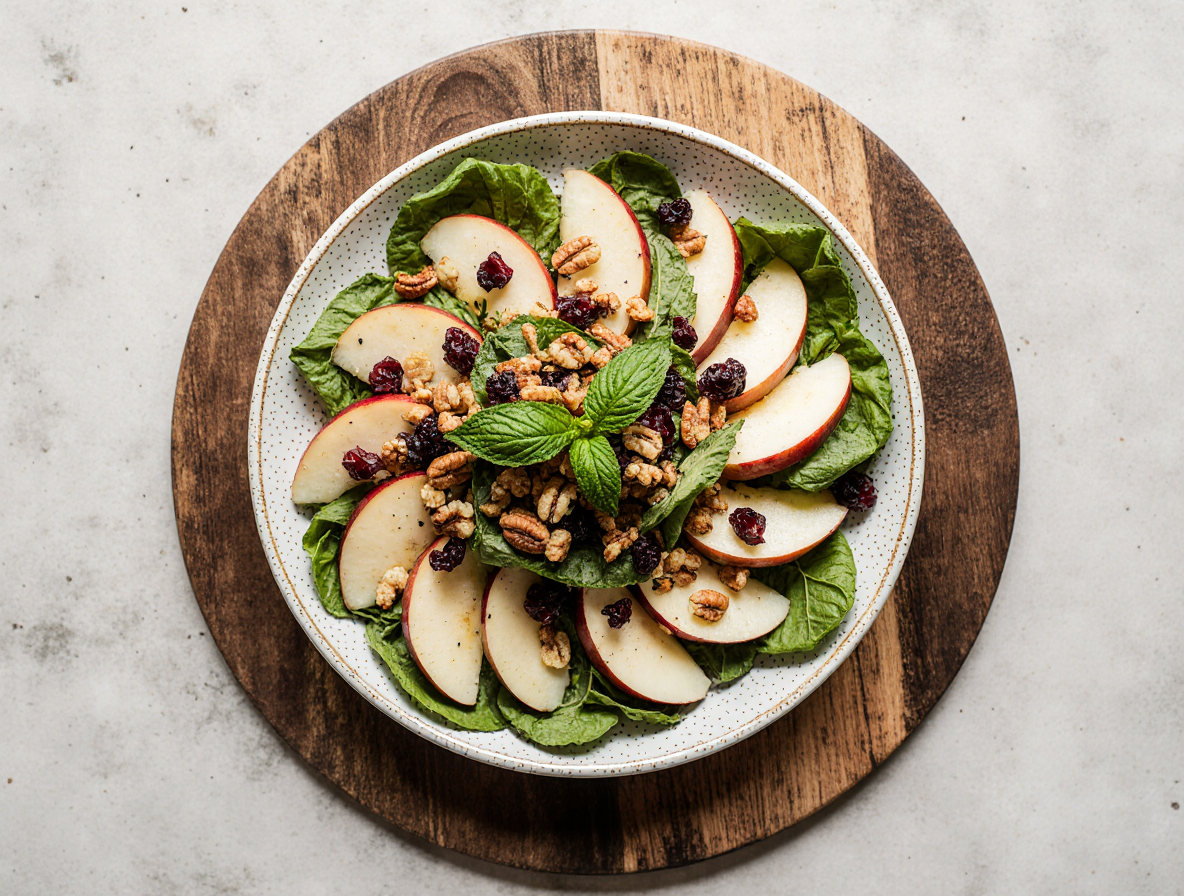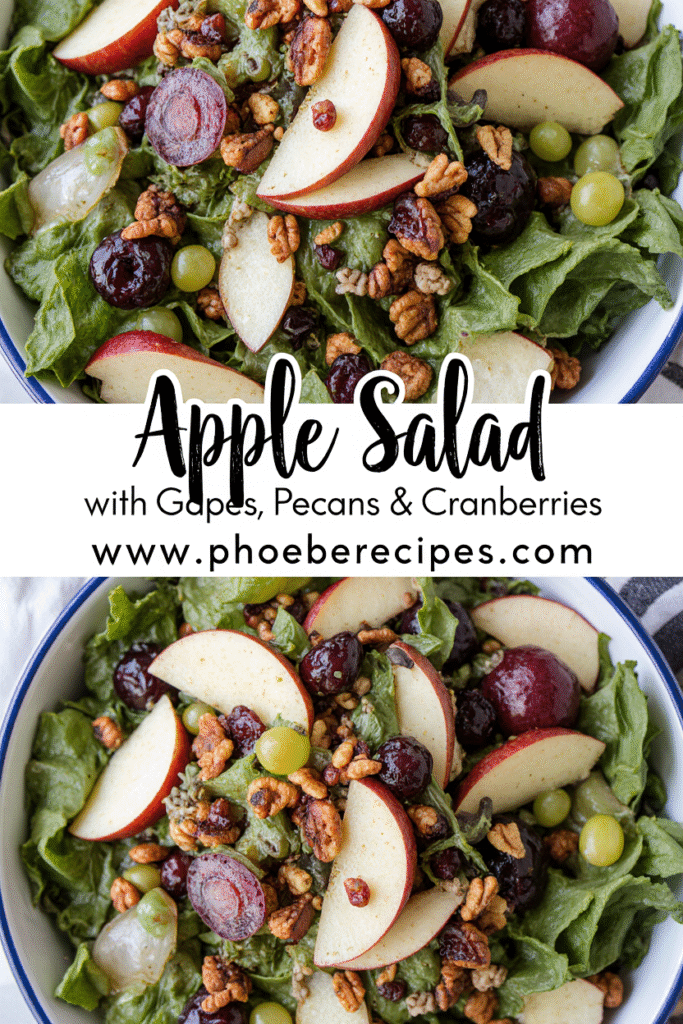The Secret to Perfect Apple and Grape Salad (Chef-Approved Recipe)
Crunchy, creamy, and bursting with fresh flavors, apple and grape salad is one of our favorite dishes to serve year-round. This delectable combination features crisp Honeycrisp apples, juicy grapes, crunchy pecans, and dried cranberries all brought together in a lightly sweetened dressing. At just 216 calories per serving, it’s not only delicious but also relatively light.
We’ve perfected our apple grape salad recipe through years of testing, and today we’re sharing all our secrets. This versatile dish works equally well as an appetizer before dinner or as a sweet ending afterward. What makes our recipe for apple salad with grapes particularly special is how quickly it comes together – with just 15 minutes of preparation and no cooking involved. Additionally, the contrasting flavors create a perfect balance – a bit of tartness from cranberries, spice from cinnamon, saltiness from nuts, and sweetness from the apples and dressing. In this guide, we’ll walk you through everything you need to know to create this chef-approved apple and grape salad recipe that will impress your family and friends.
Choosing the Right Ingredients for Apple and Grape Salad
Selecting the perfect ingredients makes all the difference between an ordinary apple grape salad and one that keeps everyone coming back for seconds. Since this refreshing dish showcases raw fruits, the quality and type of each component truly matters.
When it comes to apples, crispness and browning resistance should guide your selection. For salads, you’ll want varieties that maintain their texture and don’t discolor quickly after cutting. Pink Lady apples shine here – their bright white flesh browns slower than other varieties while offering a wonderful tart flavor. Furthermore, Honeycrisp apples stand out for their juiciness and excellent balance of sweetness and tartness, making them slow to brown as well. Other excellent options include Cortland (which hardly browns at all), Ambrosia (with honey-flavored flesh), Fuji (for incredible crispness), and Gala (with tender flesh that doesn’t leave stringy skin).
For grapes, both red and green seedless varieties work beautifully. Red grapes tend to have higher flavonoid content, making them richer in antioxidants than green varieties. Generally, I recommend using both colors for visual appeal – red grapes provide a sweet flavor profile while green grapes offer a slightly more tart, refreshing taste.
To prevent your cut apples from browning during preparation, soaking them in saltwater (½ teaspoon kosher salt per cup of water) for five minutes works remarkably well. Simply rinse afterward to remove any salt flavor.
Common complementary ingredients include:
- Nuts (walnuts or pecans) for essential crunch
- Celery for fresh texture
- Dried cranberries for tartness
- Creamy dressing components like yogurt, sour cream, or cream cheese
During summer, Granny Smith apples are particularly valuable since they maintain good snap when many other varieties have gone mealy. Conversely, in fall and winter, consider incorporating seasonal fruits like pears or mandarin oranges alongside your apples and grapes.
Remember that freshness matters tremendously – always select firm apples without visible nicks or bruises. With these ingredient selection principles, your apple and grape salad will consistently deliver exceptional flavor and texture.
Step-by-Step Guide to Making the Salad
Now let’s dive into the actual preparation process! Creating the perfect apple and grape salad is straightforward, yet there are some chef-approved techniques that elevate it from good to exceptional.
Preparing the Fruits
Begin by thoroughly washing and drying all your fruits. For grapes, slice them in half lengthwise to release more flavor and create a better texture balance. Core your apples and cut them into bite-sized cubes or small pieces. To prevent browning, immediately toss the cut apples with a squeeze of lemon juice.
Creating the Dressing
You have several delicious dressing options. For a lighter version, whisk together honey, orange juice, and lemon zest in a small bowl. Alternatively, mix Greek yogurt, a touch of honey, cinnamon, and vanilla for a creamier dressing. For extra richness, blend 8 oz fat-free Greek yogurt with 4 oz light cream cheese, ¼ cup light agave (or honey), and 1 teaspoon vanilla extract until smooth.
Assembling the Salad
First, combine all prepared fruits in a large mixing bowl. Next, pour your dressing over the fruit mixture and gently fold until everything is evenly coated. For added texture, incorporate ½ cup chopped walnuts or pecans.
Chilling and Serving
Once assembled, refrigerate your apple and grape salad for at least 1 hour before serving. This resting period allows the flavors to meld beautifully. For maximum flavor development, many chefs recommend chilling overnight.
Storage Recommendations
Store any leftover salad in an airtight container in the refrigerator. The salad will maintain its quality for up to 3 days, though the apples may gradually soften. If planning to make ahead, prepare the dressing separately and combine with the fruit just before serving to maintain optimal texture.
Tips, Variations, and Storage
Taking your apple grape salad from good to extraordinary requires a few chef secrets, creative variations, and proper storage techniques. Let’s explore how to perfect this versatile dish!
Making this salad ahead of time can be a real time-saver for busy gatherings. Prepare it up to a day in advance for optimal flavor development—in fact, many chefs believe it tastes even better after chilling overnight. For longer planning, store the dressing separately from the fruit and combine just before serving.
When it comes to storage, keep your finished apple grape salad in an airtight container in the refrigerator for up to 3 days. However, the quality will gradually decline as fruits absorb the dressing. To maintain maximum freshness, cover the salad well and return it to the refrigerator immediately after serving.
Looking to switch things up? Try these creative variations:
- Fruit substitutions: Replace grapes with berries, mandarin segments, pineapple chunks, or dried cranberries for seasonal adaptations. In fall and winter, incorporate pears, apples, and figs for a cozy twist.
- Nut options: Swap pecans for walnuts, almonds, sunflower seeds, or pistachios—which offer complete protein with all nine essential amino acids. Toast nuts first for enhanced flavor.
- Dressing alternatives: Experiment with coconut yogurt instead of regular yogurt for added creaminess plus gut-healthy probiotics. For a dairy-free version, substitute coconut yogurt and coconut cream.
To prevent browning, always cut apples last in your preparation sequence. Immediately toss cut apples with citrus juice—lemon, lime, orange, or pineapple all work effectively. For extra protection, douse all cut fruit with an acidic juice before adding dressing.
Moreover, chill your mixing bowl and utensils before whipping cream-based dressings for faster, better results. This small step makes a noticeable difference in the final texture of your apple grape salad.
Conclusion
This apple and grape salad truly stands out as a perfect blend of flavors, textures, and nutritional benefits. Throughout this guide, we’ve shared our chef-approved techniques for creating this delightful dish that works wonderfully as both an appetizer and dessert. The combination of crisp apples, juicy grapes, crunchy nuts, and tangy cranberries creates a symphony of flavors that will impress family and friends alike.
The beauty of this recipe certainly lies in its simplicity and adaptability. You can easily customize it based on seasonal availability or personal preferences. Additionally, at just 216 calories per serving, this refreshing salad offers a healthier alternative to many traditional desserts without sacrificing taste.
We particularly love how this dish can be prepared ahead of time, actually improving in flavor as it chills overnight. Nevertheless, remember to follow our storage recommendations to maintain optimal freshness and texture – especially when dealing with cut apples that tend to brown quickly.
Whether you stick with our classic recipe or experiment with the suggested variations, this apple and grape salad will undoubtedly become a staple in your culinary repertoire. The contrast between sweet fruits, tart cranberries, and savory nuts creates a balanced dish that satisfies various taste preferences.
The next time you need a quick, impressive, and delicious dish for any occasion, give this apple and grape salad a try. After all, the best recipes are those that combine simplicity with extraordinary flavor – and this one certainly delivers on both fronts!
FAQs
Q1. What makes an apple and grape salad special? An apple and grape salad is special because it combines crisp apples, juicy grapes, crunchy nuts, and tangy cranberries, creating a perfect balance of flavors and textures. It’s versatile, nutritious, and can be served as both an appetizer and a dessert.
Q2. How can I prevent apples from browning in my salad? To prevent apples from browning, toss them with lemon juice immediately after cutting. You can also soak them in saltwater (½ teaspoon kosher salt per cup of water) for five minutes, then rinse before adding to the salad.
Q3. What are the best apple varieties to use in a fruit salad? The best apple varieties for salads are those that maintain their crispness and resist browning. Excellent choices include Honeycrisp, Pink Lady, Fuji, Gala, and Granny Smith. These apples offer a good balance of sweetness and tartness while keeping their texture.
Q4. Can I make apple and grape salad ahead of time? Yes, you can prepare apple and grape salad up to a day in advance. In fact, many chefs believe it tastes even better after chilling overnight. For optimal freshness, store the dressing separately and combine it with the fruit just before serving.
Q5. How long can I store apple and grape salad? Apple and grape salad can be stored in an airtight container in the refrigerator for up to 3 days. However, the quality may gradually decline as the fruits absorb the dressing. For best results, cover the salad well and return it to the refrigerator immediately after serving.


